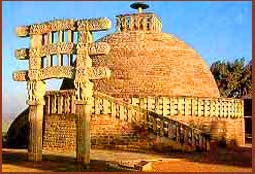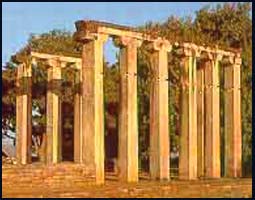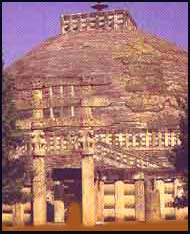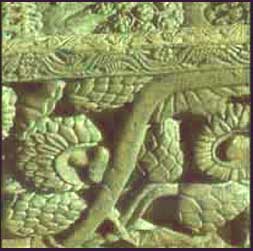| Destinations
|
|||
Sanchi is a  serene hill crowned by a group of stupas, monasteries, temples and pillars dating from 3rd Century BC to the 12th Century AD. The glory that was Sanchi, an ancient seat of Buddhist learning and place of pilgrimage, can still be experienced in its complex structures where many Buddhist legends found expression in the rich sculpture. serene hill crowned by a group of stupas, monasteries, temples and pillars dating from 3rd Century BC to the 12th Century AD. The glory that was Sanchi, an ancient seat of Buddhist learning and place of pilgrimage, can still be experienced in its complex structures where many Buddhist legends found expression in the rich sculpture.
The Buddha is not represented through figure at Sanchi, but through symbols, as was the tradition in the early period of Buddhism. The lotus represents the Buddha's birth, the tree signifies his enlightenment, the Wheel represents his first sermon and the Stupa/ represents his nirvana or salvation. The footprints and the throne denote the Buddha's presence. Sanchi was virtually forgotten after the 13th Century until 1818, when General Taylor, a British Officer rediscovered it, half buried and well preserved. Later in 1912, Sir John Marshal, Director General of Archaeology ordered the restoration work at the site.
Some of the important monuments in Sanchi : |
More on M.P. • Overview Cities • Bhopal • Gwalior • Indore • Ujjain • Orccha • Shivpuri • Kanha
Travelogues Heritage • Erotic Art • Khajuraho
Wildlife |
||
The last of the additions to this remarkable stupa are the elaborate and richly carved four gateways or Toranas. The first of the four gateway to be erected was the one at the Southern Entrances, followed, in choronological order by the Northern, the Eastern and the Westren Gateways. The Southern Gateway reveals the birth of Gautam in a series of dramatically rich carvings. The Northern Gateway, crowned by a wheel of law, illustrates the miracle asssociated with the Buddha as told in the Jataka tales.
Stupa No 2: Dating back to the 2nd Cenury BC, it stands at the very edge of the hill and its most striking feature is the stone balustrade that surrounds it. Stupa No 3: Situated northeast of the great stupa is where the relics of Sariputra and Mahamogalana, the two famous disciples of the Buddha were found in its inner most chambers. The hemispherical dome is crowned, as a mark of its special religious significance, with an umbrella of polished stone. It has only one gateway. This structure belongs to the period between 150-140 BC. Ashoka Pillar: With its four lion head stump, erected during the 3rd Century BC, is situated close to the Southern Gateway of the Great Stupa. Though, similarly to the intricately carved pillar in Sarnath, the lions did not support a "Wheel of Law" (Dharmachakra). A unique feature of this pillar is its brilliant polish. Gupta Temple: Built in the 4th Century AD, it is in ruins now. It is one of the earlist known example of temple architecture in India. It consists of a simple flat roofed chamber with a pillared porch in front.
Great Bowl: Carved out of one block of stone, contained food that was distributed amongst the monks of Sanchi. The Archaeological Survey of India Museum, situated at the entrance to the monument, exhibits findings and remains of the excavated site. Among these are caskets, pottery, parts of gateways, lion capital of the Ashoka Pillar and images. Access & Accommodation
For reservations contact (0755) 554340, 554341, 554342, 554343, Other places to visit Vidisha - 10 km from Sanchi, an ancient city which was deserted after 6th century A.D. The ruins of a Brahmanical shrine (dated not later than 2 B.C.)at Vidisha, dedicated to Vishnu reveal that the foundation bricks were cemented together with lime mortar, the first known example of the use of cement in India. Vidisha Museum has a superb collection from Besnagar's earliest antiquities. Udaygiri Caves - 13 km from Sanchi and 4 km from Vidisha has a group of rock-cut caves. An inscription in one of these states that it was produced during the reign of Chandragupta II (382-401 A.D.), thus dating these caves to 4-5 A.D. Gyraspur - 41 km north-east of Sanchi represent ruins from 9-10 century A.D. in the form of Athakhambe (eight pillars) and Chaukhambe (four pillars), the remains of the columned halls of two temples. Udaypur - 90 km from Bhopal via Vidisha has the colossal Neelkantheswara temple from Parmara art and architecture of 11th century A.D. Information: Courtesy Government of India
|
|||
Editor: Romola Butalia (c) India Travelogue. All rights reserved. |
|||
 The paved procession path around it has become smooth by centuries of pilgrim's visit. Built orginally as an earthern stupa by the Emperor Ashoka, it was rebuilt in the 3rd and 2nd Centuries BC.
The paved procession path around it has become smooth by centuries of pilgrim's visit. Built orginally as an earthern stupa by the Emperor Ashoka, it was rebuilt in the 3rd and 2nd Centuries BC. 
 The Eastern Gateway, depicts the young prince, Gautam, leaving his father's palace, renouncing worldly life to seeek enlightenment. The inner face of the right pillar portrays the dream of Maya, the mother of Buddha, when she conceived him. The Western Gateway depicts the Seven incarnations of the Buddha, four represented by tress and three by stupas; the Buddha preaching his first sermon at the Deer Park, Sarnath and the Chhaddanta Jataka tale.
The Eastern Gateway, depicts the young prince, Gautam, leaving his father's palace, renouncing worldly life to seeek enlightenment. The inner face of the right pillar portrays the dream of Maya, the mother of Buddha, when she conceived him. The Western Gateway depicts the Seven incarnations of the Buddha, four represented by tress and three by stupas; the Buddha preaching his first sermon at the Deer Park, Sarnath and the Chhaddanta Jataka tale.
 Temple 18: A Chaitya Hall, situated in front of the Southern Gateway of the Great Stupa is comparatively recent (around 7th Century A.D.) resembles the rock-cut chaitya halls at Karla Caves in maharashtra. The Monastery amd Temple 45, built between the 7th and 11th Centuries, show more developed styles of architecture.On the ornamental doorway here, one can see the image of Buddha with an oval Halo.
Temple 18: A Chaitya Hall, situated in front of the Southern Gateway of the Great Stupa is comparatively recent (around 7th Century A.D.) resembles the rock-cut chaitya halls at Karla Caves in maharashtra. The Monastery amd Temple 45, built between the 7th and 11th Centuries, show more developed styles of architecture.On the ornamental doorway here, one can see the image of Buddha with an oval Halo.